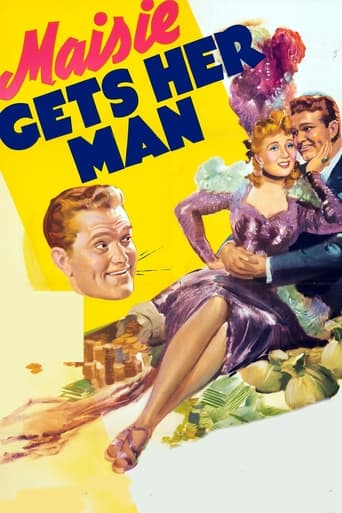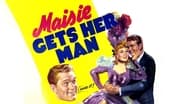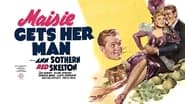JohnHowardReid
Ann Sothern (Maisie Ravier), Red Skelton (Hap Hixby), Allen Jenkins (Pappy Goodring), Donald Meek (Mr Stickwell), Lloyd Corrigan (Mr Denningham), Fritz Feld (Professor Orco), Walter Catlett (Jasper), Leo Gorcey (Cecil), Ben Welden (Percy Podd), Rags Ragland (Ears Cofflin), Frank Jenks (Art Giffman), Florence Shirley (Mrs Taylor), Pamela Blake (Elsie), Frank Faylen (theater manager), Phil Van Zandt (stage manager), Harry Tyler (peeler salesman), Joe Yule (elevator man), Pat Flaherty (bone-crusher), Esther Dale (Elsie's mother), Willie Best (Sam), Robert Emmett O'Connor (Frawley).Director: ROY DEL RUTH. Screenplay: Betty Reinhardt, Mary C. McCall Jr. Story: Betty Reinhardt and Ethel Hill. Based on the character created by Wilson Collison. Photography: Harry Stradling. Film editor: Fredrick Y. Smith. Supervising art director: Cedric Gibbons. Associate art director: William Ferrari. Set decorator: Edwin B. Willis. Costumes: Kalloch. Music: Lennie Hayton. Song, "Cookin' with Gas" by Roger Edens. Dance choreography: Danny Dare. Sound supervisor: Douglas Shearer. Western Electric Sound System. Producer: J. Walter Ruben.Copyright 26 May 1942 by Loew's Inc. A Metro-Goldwyn-Mayer picture. New York opening at Loew's Criterion: 15 July 1942. U.S. release: Not recorded. Australian release: 7 January 1943. 8 reels. 7,704 feet. 85 minutes. U.K. release title: SHE GOT HER MAN. SYNOPSIS: Down-but-not-out hoofer meets a stage-struck country boy eager to make his comic mark on Broadway. (Theodore Strauss in his New York Times review suggests the script was inspired by A.J. Liebling's "Jollity Building" series of short pieces in The New Yorker).NOTES: Unlike the Andy Hardy series which, although produced by M-G- M's "B" unit, were sold as "A" attractions, the studio's nine Maisie entries never amounted to anything more than fodder for the lower half of double bills. All the same, the series was well-liked. In working-class neighborhoods, Maisie was often booked for Saturday nights, particularly if the main feature was thought to lack drawing power. "Maisie Gets Her Man" was the 6th of the series.COMMENT: Better than average offering in the series — thanks more to Roy Del Ruth's good direction than to any great virtues of the script. Some of the ideas are good but they are almost smothered in a plethora of lightweight dialogue. Conclusion is disappointing and seems to have been hurriedly tacked on.My guess is that Harry Stradling did the photography while he was asleep.OTHER VIEWS: Maisie Gets Her Man just limps along without ever being very amusing or ruefully touching. The script lacks the flavor of A.J. Liebling's sketches, the direction is ambling. Skelton labors heroically over some soggy material — but all to little avail. — Theodore Strauss in The New York Times.I'm not a great fan of Red Skelton, but for once he's perfectly cast as an aggressively obnoxious, unfunny comic, whose nerve fails him when most needed. Not exactly an enjoyable interpretation, but accurate. More appealing characters are enacted by Allen Jenkins (as an undischarged bankrupt reduced to running a rundown office block), Donald Meek (as the mean-tempered, miserly-minded landlord), and some of the tenants of this Jollity Building, including surly Leo Gorcey, gushingly phony Lloyd Corrigan, crick-necked Walter Catlett and tricky Ben Welden. Ann Sothern, as usual, not only tends to overplay but unashamedly hogs the camera. Aside from this unwelcome indulgence of his star, Del Ruth's direction seems capable enough. A boost is provided by Harry Stradling's attractively glossy camera-work. Nonetheless, despite the originality of the film's setting and characters, the script's main story remains a liability. Not only does it firmly adhere to traditional lines, but finally peters out in a tamely naïve conclusion. = JHR writing as Charles Freeman.
ndean
Spoilers Included - It's strange to see the well-known A.J.Liebling story The Jollity Building used in this film. A lot of the characters (I see Jack McGuire, Morty Ormont, Jerry Rex and Dave, Hi Sky, Marty the Clutch, and Barney the lunch counter owner), sets, and lingo are lifted whole from the story, and many of the situations as well. I didn't see Liebling's name in the credits, though. All the names and a few of the situations were changed in the building, and the locale (Chicago instead of NYC), but it's still quite obviously the Liebling story with a boy/girl romance thrown in. It's a likable film, and Allen Jenkins is very impressive as the building manager (he could be straight from the story's gloomy Morty Ormont).
Peter Brockert
Red plays the clown on vaudeville trying to get an act together when he meets up with Maisie who just lost her booking. They team up and flop miserably.They then run across a man who offers to set them up in his business only to get them into the business far enough to get them indicted while he takes off. Maisie and Red fall for each other, but Red already has a fiancé back home. He can't get the nerve up to tell his old flame it's over with so Maisie hits the road also, right before the cops show up. She accidentally runs into the nice man who helped them out and gets suspicious.





